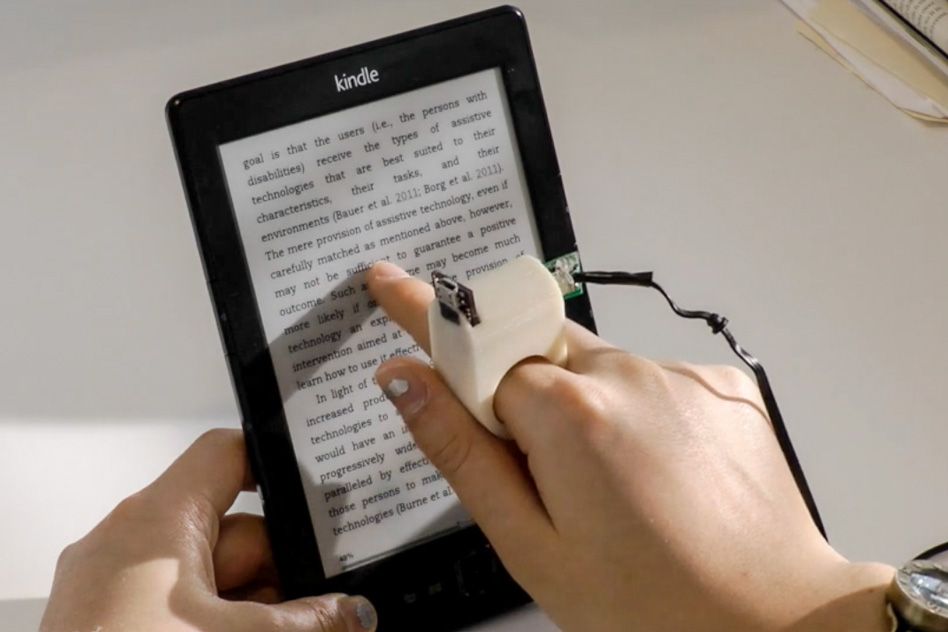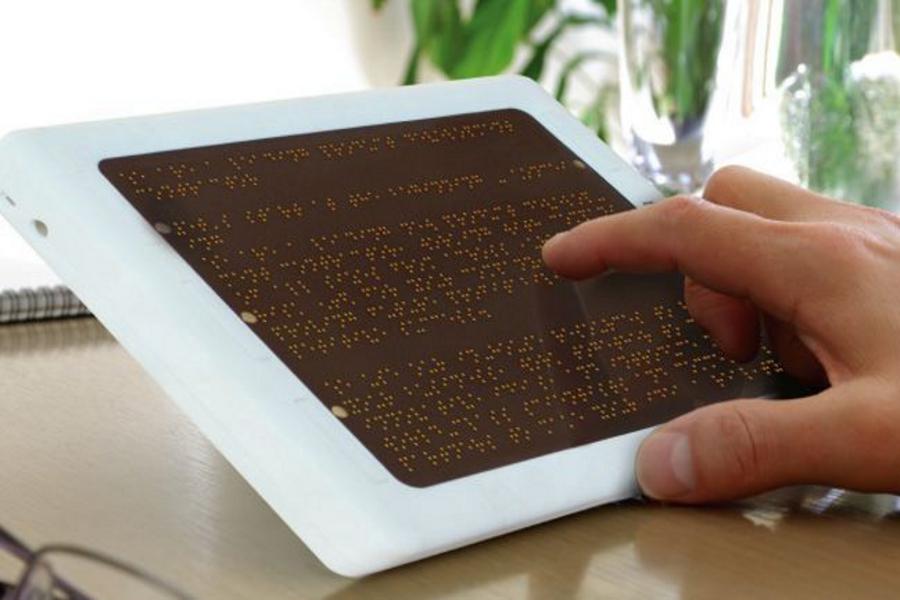Discover Innovative Tools Made for the Aesthetically Impaired
The advancement of cutting-edge tools for the aesthetically impaired stands for a considerable improvement in accessibility and freedom. Technologies such as smart glasses with AI capacities and mobile applications designed to give acoustic summaries are reshaping day-to-day experiences for users.
Smart Glasses for Navigating

Smart glasses made for navigating are changing the means aesthetically impaired people engage with their environment. These innovative devices make use of a mix of electronic camera technology, expert system, and acoustic responses to offer real-time details regarding surroundings. By using challenge discovery systems, clever glasses can signal individuals to potential threats, allowing more secure wheelchair in both unknown and acquainted settings.
The assimilation of GPS innovation even more improves navigation abilities, permitting individuals to obtain auditory instructions as they move. This hands-free strategy not only promotes freedom however additionally equips aesthetically impaired people to browse urban landscapes with boosted confidence. Additionally, numerous clever glasses are equipped with functions that recognize sites and road signs, supplying contextual details that enhances the individual experience.
In addition, the advancement of these tools is constantly progressing, with firms functioning to improve the accuracy of item acknowledgment and expand the range of navigational functions. As clever glasses come to be a lot more budget-friendly and obtainable, they hold the possible to significantly change daily life for visually impaired users. Ultimately, these innovative tools represent a vital action towards inclusivity, offering boosted mobility and a greater sense of autonomy for individuals navigating the globe around them.

Mobile Apps for Daily Living
Just how can mobile applications enhance the every day lives of visually damaged individuals? Mobile apps are changing the way visually damaged individuals browse their environments, manage everyday jobs, and access information. These applications provide essential assistance via various capabilities, fostering self-reliance and boosting lifestyle.
Several ingenious mobile applications are created particularly for everyday living. For instance, applications like Be My Eyes attach visually damaged users with sighted volunteers through video phone calls, enabling them to get real-time aid with jobs such as reviewing tags or browsing strange spaces. Seeing AI, established by Microsoft, uses artificial intelligence to define environments, checked out text, and recognize things, efficiently transforming a smartphone right into an effective tool for day-to-day help.
Furthermore, navigating apps customized for the aesthetically impaired, such as Aira and BlindSquare, supply audio-based instructions and environmental information, making it possible for customers to traverse their environments safely and with confidence. Past navigation and prompt support, mobile applications also sustain organization and task monitoring, with features that aid customers set reminders, develop order of business, and track consultations. In summary, mobile applications act as essential resources, encouraging visually damaged individuals to lead even more independent and fulfilling lives.
Wearable Technologies for Aid
Empowerment via innovation is significantly apparent in the world of wearable devices made to assist aesthetically impaired people. These innovative devices incorporate effortlessly right into day-to-day life, boosting navigation and supplying important responses to users. For instance, wise glasses equipped with cams can recognize Recommended Site faces and check out text aloud, enabling individuals to communicate even more with confidence in social and professional settings.
An additional notable development is the usage of haptic feedback systems in wearable gadgets. These systems use vibrations or various other responsive signals to convey information about the individual's atmosphere, such as barriers or modifications in surface, boosting mobility and safety. Wearable go to the website technologies also include wristbands that connect to smartphones, notifying individuals to notices through subtle vibrations, hence enhancing connectivity without reliance on visual signs.
As these modern technologies proceed to advance, they are not only improving independence for visually damaged people however likewise fostering a greater sense of inclusion in culture. By linking the void between challenges encountered in day-to-day living and the possibility for autonomy, wearable technologies serve as crucial devices in the pursuit for equal rights and empowerment for those with visual impairments.
Sound Description Tools
Sound description tools play a critical function in enhancing accessibility for aesthetically impaired people, supplying them with the capability to engage with aesthetic media. Wearable technology for low vision. These tools use narrated descriptions of key aesthetic aspects in movies, television programs, and live performances, ensuring that individuals can fully understand the context and emotions shared through visuals
Sound description can be incorporated into numerous platforms, consisting of streaming services, cinema testings, and live theater. Lots of prominent streaming services now consist of audio description as an accessibility function, permitting audiences to select it conveniently. In enhancement to mainstream media, specialized applications also exist, supplying audio descriptions for art exhibitions, galleries, and various other cultural events.
The effectiveness of audio description rests on the skill of the storytellers, that need to communicate aesthetic details succinctly without taking away from the initial audio. Developments in this area are also leading the way for more individualized experiences, where customers can change the degree of information and pacing according to their choices.
Braille Innovations and Devices
Braille innovations and tools have dramatically transformed the method visually damaged individuals engage with message and info. Modern advancements have actually led to the development of functional tools that boost literacy and independence amongst customers. Significantly, see it here Braille present technologies have actually evolved, permitting for dynamic reading experiences. These gadgets transform digital message right into Braille, enabling users to access a huge array of info on computers, tablet computers, and smart devices.
In addition, mobile Braille notetakers combine conventional Braille input with modern performances, helping with note-taking, scheduling, and file modifying on the go. Braille displays and notetakers. These portable devices often include text-to-speech abilities, bridging the gap between Braille and auditory information
On top of that, innovative Braille printers have emerged, allowing individuals to generate Braille labels, records, and instructional products successfully. This availability cultivates greater engagement in expert and academic environments, inevitably promoting inclusivity.
Additionally, research right into smart Braille modern technologies proceeds to increase. Tools that incorporate expert system are being checked out to provide real-time navigating help and contextual information, improving the user experience in diverse setups. In general, these developments reflect a dedication to encouraging visually damaged people through innovation, guaranteeing they can conveniently gain access to and engage with the globe around them.

Final Thought
The innovation of innovative tools for the aesthetically impaired considerably improves independence and high quality of life. These innovations not only foster better addition yet also advertise freedom in everyday activities, inevitably adding to an extra obtainable and equitable society for aesthetically damaged people.
As wise glasses become more inexpensive and available, they hold the potential to substantially transform everyday life for visually impaired customers. Mobile apps are revolutionizing the way aesthetically damaged individuals navigate their atmospheres, handle day-to-day jobs, and gain access to information. Apps like Be My Eyes attach aesthetically impaired users with sighted volunteers by means of video telephone calls, enabling them to get real-time assistance with tasks such as reading tags or browsing unfamiliar spaces.Furthermore, navigating apps tailored for the aesthetically damaged, such as Aira and BlindSquare, use audio-based instructions and environmental details, enabling individuals to traverse their surroundings securely and with confidence.The advancement of innovative tools for the visually impaired significantly improves independence and top quality of life.